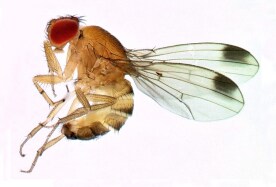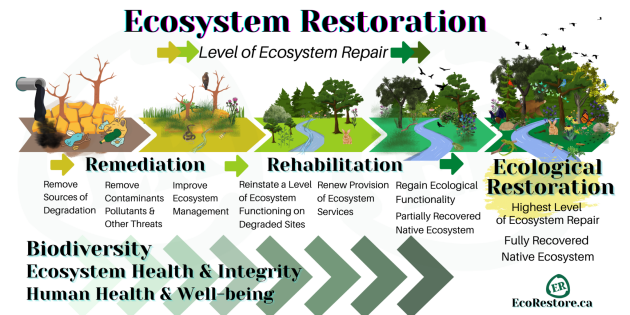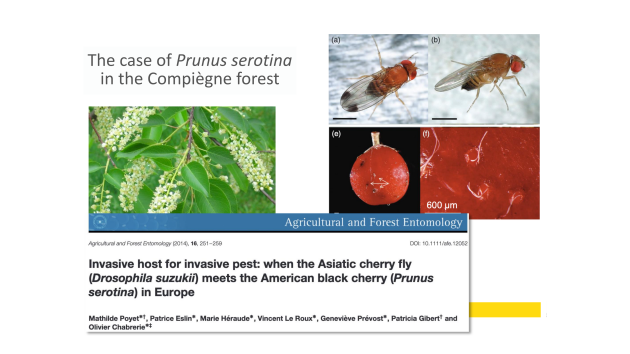Can broken ecosystems be fixed?
The steps to ecosystem restoration
Restoration is defined by the Society of Ecological Restoration as "the process of assisting the recovery of an ecosystem that has been degraded, damaged, or destroyed".
There are different steps to help ecosystems recover after human-induced degradation.
In the remediation phase, pollutants and impermeable coatings are removed.
This is not sufficient to ensure that a functional ecosystem regenerates.
In the rehabilitation phase, interventions take place such as removal of invasive species, (re)introduction of native species, establishment of wildlife corridors.
Invasive species
How to deal with invasive species?
Example : The case of Prunus serotina in the Compiègne forest
Let us take a local example from the Compiègne forest.
Prunus serotina, also known as black cherry, is a forest tree originating from America.
Introduced in Compiègne in the 19th century as an ornamental tree, it soon escaped from private gardens and naturalized in the forest.
Its presence was first documented in the 1970s.
Today, it is found in 90% of the forest.
How does it affect the local ecosystem?
Prunus serotina is a fast growing tree, especially in Europe where pathogens that regulate populations in its native region are absent.
It outcompetes locally cultivated oak and beech trees whose growth in its shade is slowed down.
It also modifies soil conditions and nutrient cycling.
Prunus serotina seems to be able to take advantage not only of its own associated mycrorrhizal fungi to absorb nutrients from the soil, but also from locally existing fungal networks.
Reaction of local stakeholders
In its native environment, Prunus serotina is appreciated for its timber, fruits and medicinal properties.
In Europe, its rapid propagation mostly raises concern because it has a negative impact on local forestry, that values other types of trees. Although some people enjoy its fruits and the colors of its leaves, the general consensus is that Prunus serotina is invasive and should be fought against.
Example : Drosophila suzukii, the spotted wing drosophila

Drosophila suzukii, also known as spotted wing drosophila, is an insect originating from Southeast Asia. It was first described in America in 2008 and in Europe in 2010 and is considered a fruit crop pest.
Unlike other fruit flies, which target rotting fruits, Drosophila suzukii lays its eggs under the skin of fresh fruits, ruining cultures of berries, plums and other crops.
Could this species be the first known enemy of Prunus serotina in Europe?
A study in the Compiègne forest revealed that Drosophila Suzukii is encountered more frequently on Prunus serotina trees, more precisely on fruits with immature seeds. By preventing fruit maturation, Drosophila Suzukii could help mitigate Prunus serotina invasion, although this effect has not been demonstrated yet.
On the other hand, the researchers also conclude that Prunus serotina is likely to act as a reservoir for Drosophila Suzukii and facilitate its propagation. They suggest to use Prunus serotina as an indicator to monitor Drosophila Suzukii invasion.
This double example illustrates how difficult it is to predict the response of an ecosystem to the introduction of an exogenous species.
Projections can be built based on existing scientific knowledge but conditions may vary from one ecosystem to the next. We do not have the data to predict the outcomes of an encounter between two species originating from different continents, that had a priori no chance of sharing an ecosystem.
Even defining the goals (should an invasive species be eradicated? what should it be replaced with?) is not as obvious as it may seem at first glance.
(Re)creating ecosystems
Can we design or recreate ecosystems starting with a blank page?
Farmers who work with permaculture think of their cultures as ecosystems. However, they have only limited control on these ecosystems, which are not fully autonomous.

